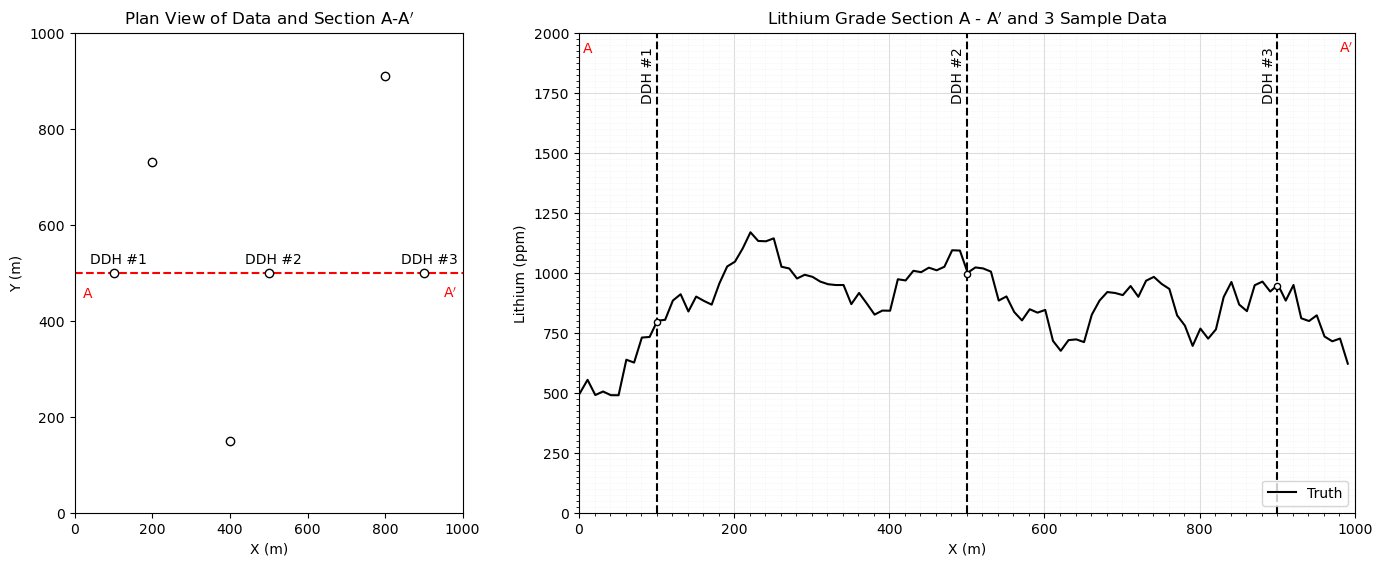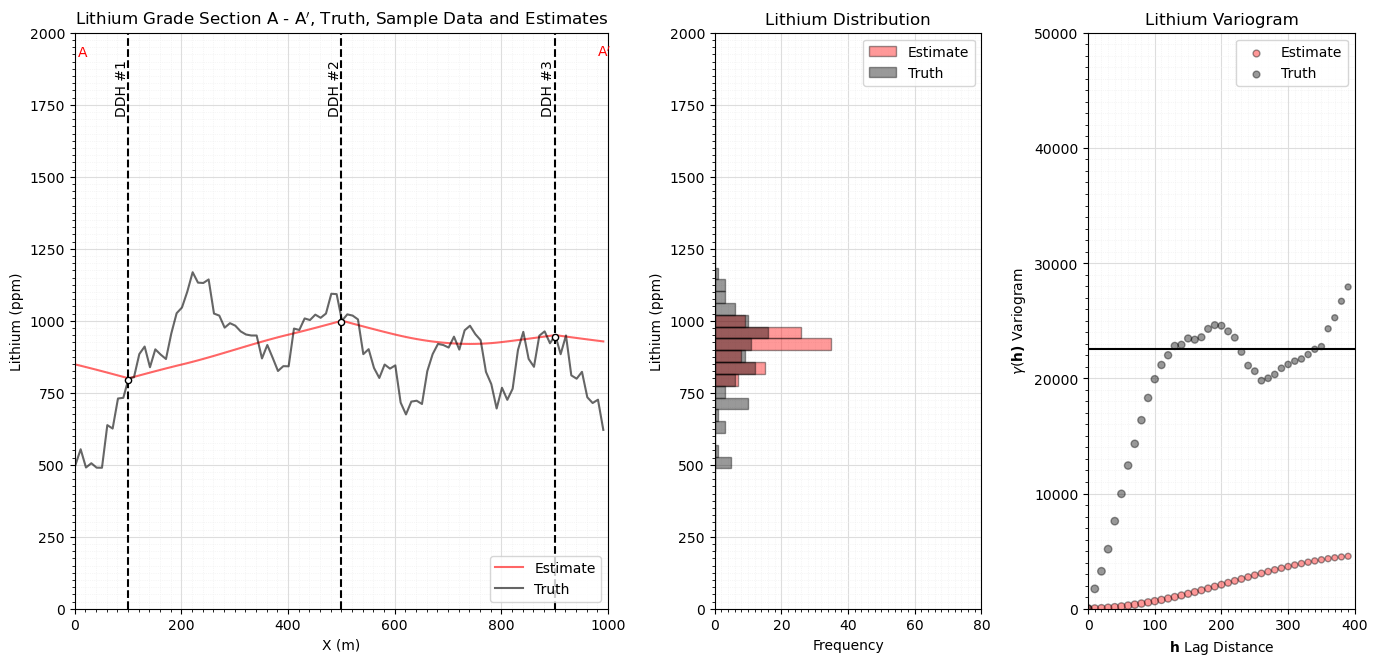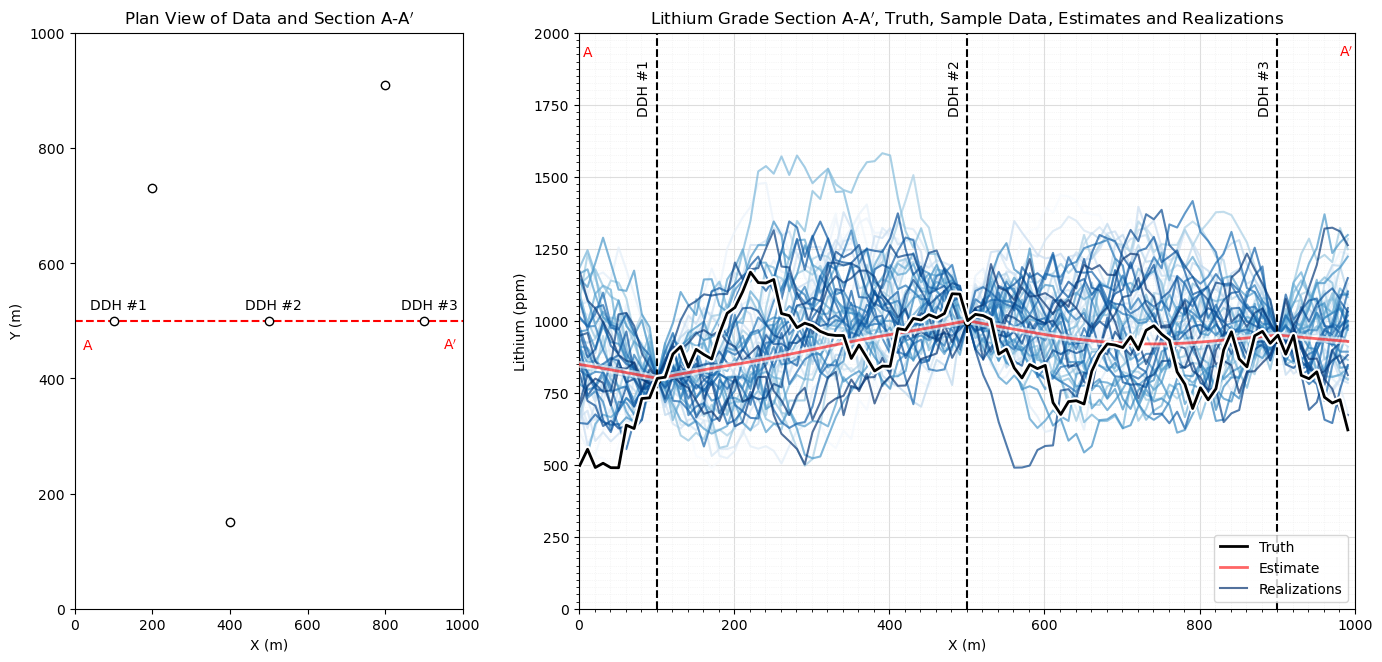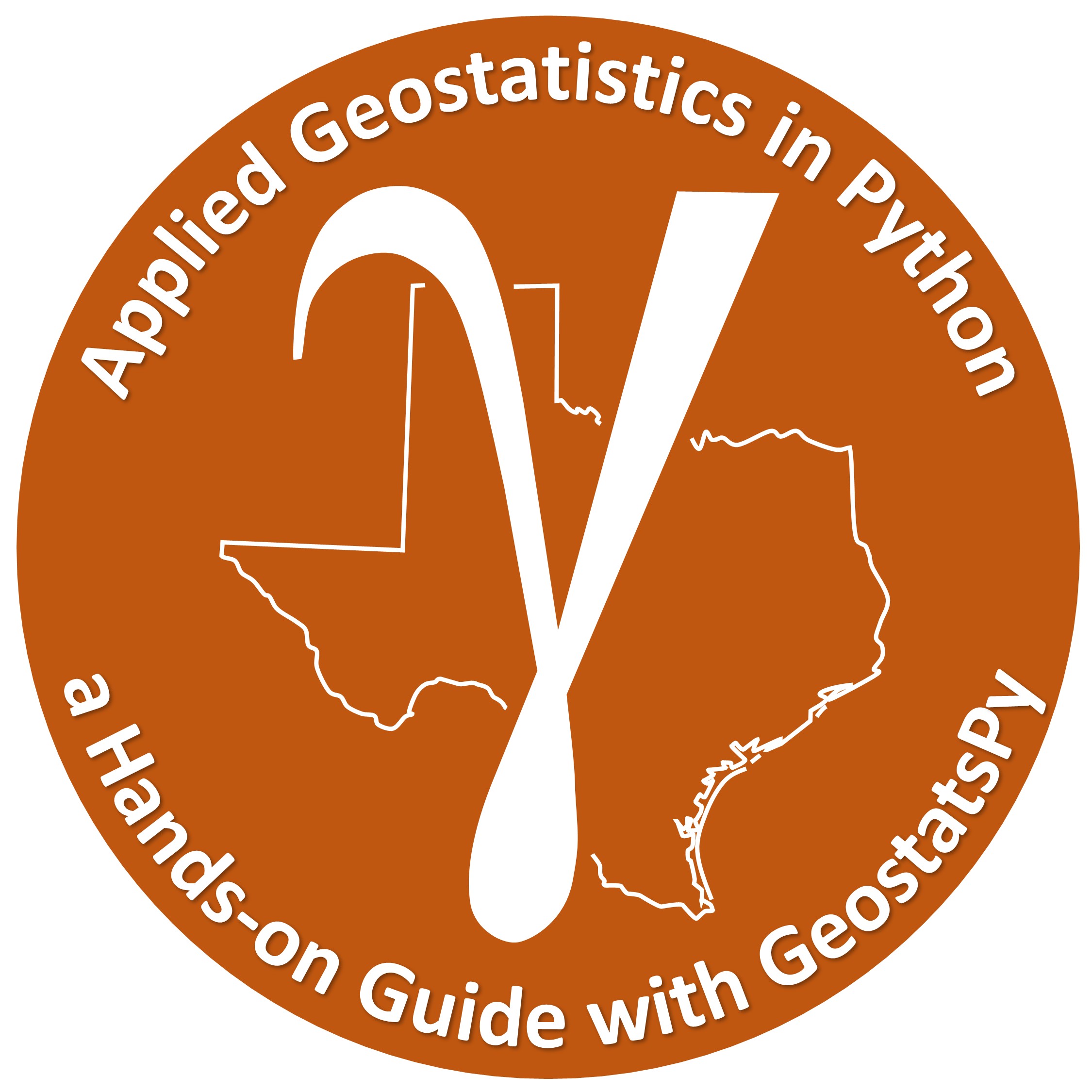Kriging vs. Simulation, a 1D Example#
Michael J. Pyrcz, Professor, The University of Texas at Austin
Twitter | GitHub | Website | GoogleScholar | Geostatistics Book | YouTube | Applied Geostats in Python e-book | Applied Machine Learning in Python e-book | LinkedIn
Chapter of e-book “Applied Geostatistics in Python: a Hands-on Guide with GeostatsPy”.
Cite this e-Book as:
Pyrcz, M.J., 2024, Applied Geostatistics in Python: a Hands-on Guide with GeostatsPy [e-book]. Zenodo. doi:10.5281/zenodo.15169133
The workflows in this book and more are available here:
Cite the GeostatsPyDemos GitHub Repository as:
Pyrcz, M.J., 2024, GeostatsPyDemos: GeostatsPy Python Package for Spatial Data Analytics and Geostatistics Demonstration Workflows Repository (0.0.1) [Software]. Zenodo. doi:10.5281/zenodo.12667036. GitHub Repository: GeostatsGuy/GeostatsPyDemos
By Michael J. Pyrcz
© Copyright 2024.
This chapter is a tutorial for / demonstration of Spatial Estimation with Kriging vs. Simulation with Sequential Gaussian Simulation (SGSIM) with a 1D example.
YouTube Lecture: check out my lectures on:
For your convenience here’s a summary of the salient points.
Estimation vs. Simulation#
Let’s start by comparing spatial estimation and simulation.
Estimation:
honors local data
locally accurate, primary goal of estimation is 1 estimate!
too smooth, appropriate for visualizing trends
too smooth, inappropriate for flow simulation
one model, no assessment of global uncertainty
Simulation:
honors local data
sacrifices local accuracy, reproduces histogram
honors spatial variability, appropriate for flow simulation
alternative realizations, change random number seed
many models (realizations), assessment of global uncertainty
Spatial Estimation#
Consider the case of making an estimate at some unsampled location, \(𝑧(\bf{u}_0)\), where \(z\) is the property of interest (e.g. porosity etc.) and \(𝐮_0\) is a location vector describing the unsampled location.
How would you do this given data, \(𝑧(\bf{𝐮}_1)\), \(𝑧(\bf{𝐮}_2)\), and \(𝑧(\bf{𝐮}_3)\)?
It would be natural to use a set of linear weights to formulate the estimator given the available data.
We could add an unbiasedness constraint to impose the sum of the weights equal to one. What we will do is assign the remainder of the weight (one minus the sum of weights) to the global average; therefore, if we have no informative data we will estimate with the global average of the property of interest.
We will make a stationarity assumption, so let’s assume that we are working with residuals, \(y\).
If we substitute this form into our estimator the estimator simplifies, since the mean of the residual is zero.
while satisfying the unbaisedness constraint.
Kriging#
Now the next question is what weights should we use?
We could use equal weighting, \(\lambda = \frac{1}{n}\), and the estimator would be the average of the local data applied for the spatial estimate. This would not be very informative.
We could assign weights considering the spatial context of the data and the estimate:
spatial continuity as quantified by the variogram (and covariance function)
redundancy the degree of spatial continuity between all of the available data with themselves
closeness the degree of spatial continuity between the avaiable data and the estimation location
The kriging approach accomplishes this, calculating the best linear unbiased weights for the local data to estimate at the unknown location. The derivation of the kriging system and the resulting linear set of equations is available in the lecture notes. Furthermore kriging provides a measure of the accuracy of the estimate! This is the kriging estimation variance (sometimes just called the kriging variance).
What is ‘best’ about this estimate? Kriging estimates are best in that they minimize the above estimation variance.
Properties of Kriging#
Here are some important properties of kriging:
Exact interpolator - kriging estimates with the data values at the data locations
Kriging variance can be calculated before getting the sample information, as the kriging estimation variance is not dependent on the values of the data nor the kriging estimate, i.e. the kriging estimator is homoscedastic.
Spatial context - kriging takes into account, furthermore to the statements on spatial continuity, closeness and redundancy we can state that kriging accounts for the configuration of the data and structural continuity of the variable being estimated.
Scale - kriging may be generalized to account for the support volume of the data and estimate. We will cover this later.
Multivariate - kriging may be generalized to account for multiple secondary data in the spatial estimate with the cokriging system. We will cover this later.
Smoothing effect of kriging can be forecast. We will use this to build stochastic simulations later.
Sequential Gaussian Simulation#
With sequential Gaussian simulation we build on kriging by:
adding a random residual with the missing variance
sequentially adding the simulated values as data to correct the covariance between the simulated values
The resulting model corrects the issues of kriging, as we now:
reproduce the global feature PDF / CDF
reproduce the global variogram
while providing a model of uncertainty through multiple realizations
In this workflow we run kriging estimates and multiple simulation realizations, and compare the statistics.
Load the Required Libraries#
The following code loads the required libraries.
import geostatspy.GSLIB as GSLIB # GSLIB utilities, visualization and wrapper
import geostatspy.geostats as geostats # GSLIB methods convert to Python
import geostatspy
print('GeostatsPy version: ' + str(geostatspy.__version__))
GeostatsPy version: 0.0.78
We will also need some standard packages. These should have been installed with Anaconda 3.
import os # set working directory, run executables
from tqdm import tqdm # suppress the status bar
from functools import partialmethod
tqdm.__init__ = partialmethod(tqdm.__init__, disable=True)
ignore_warnings = True # ignore warnings?
import numpy as np # ndarrays for gridded data
import pandas as pd # DataFrames for tabular data
import matplotlib.pyplot as plt # for plotting
from matplotlib.ticker import (MultipleLocator, AutoMinorLocator) # control of axes ticks
from matplotlib import gridspec # custom subplots
plt.rc('axes', axisbelow=True) # plot all grids below the plot elements
if ignore_warnings == True:
import warnings
warnings.filterwarnings('ignore')
from IPython.utils import io # mute output from simulation
Simulation Parameters, Data with Reference Distribution#
We need a full reference distribution for the feature of interest, but for unconditional simulated realizations.
we accomplish this with a set of data samples outside the range of spatial correlation from the AOI.
this is used by the sequential Gaussian simulation program to support the distribution backtransformation from Gaussian space.
while the data will inform the distribution transformation, they are outside the range of spatial continuity and will not locally condition the model
nx = 100; ny = 1; xsiz = 10.0; ysiz = 10.0; xmn = 5.0; ymn = 5.0; nxdis = 1; nydis = 1 # grid specification
ndmin = 0; ndmax = 20; radius = 2000; skmean = 0; tmin = -99999; tmax = 99999; nreal = 10 # simulation parameters
df = pd.DataFrame(np.vstack([np.full(1000,-9999),np.random.normal(size=1000), # reference distribution outside VOI
np.random.normal(loc=1000,scale=200,size=1000)]).T, columns= ['X','Y','Lithium'])
df.loc[0,'X'] = 105; df.loc[0,'Y'] = 5.0; df.loc[0,'Lithium'] = 800 # add 3 data in VOI for visualization of conditioning
df.loc[1,'X'] = 505; df.loc[1,'Y'] = 5.0; df.loc[1,'Lithium'] = 1000
df.loc[2,'X'] = 905; df.loc[2,'Y'] = 5.0; df.loc[2,'Lithium'] = 950
df.head()
| X | Y | Lithium | |
|---|---|---|---|
| 0 | 105.0 | 5.000000 | 800.000000 |
| 1 | 505.0 | 5.000000 | 1000.000000 |
| 2 | 905.0 | 5.000000 | 950.000000 |
| 3 | -9999.0 | 0.948211 | 1060.553256 |
| 4 | -9999.0 | -1.686368 | 812.600115 |
Make Truth Model#
For visualization, simulate a consistent truth model.
we use the same reference distribution and variogram model for truth and realizations, assuming perfect / no error inference
nreal = 50; vrange = 300 # number of realizations and variogram range
vario_truth = GSLIB.make_variogram(nug=0.0,nst=1,it1=1,cc1=1.0,azi1=90.0,hmaj1=vrange,hmin1=5) # assumed variogram model
fig = plt.figure()
grid_spec = gridspec.GridSpec(ncols = 2,nrows=1,width_ratios=[1, 2])
ax0 = fig.add_subplot(grid_spec[0]) # visualize the truth and realizations
ax0.scatter([100,500,900,400,200,800],[500,500,500,150,730,910],color='white',edgecolor='black',zorder=10) # data for viz
plt.plot([0,1000],[500,500],ls='--',color='red',zorder=1)
plt.annotate(r'DDH #1',(40,520)); plt.annotate(r'DDH #2',(440,520)) ## 3 conditioning data on the section
plt.annotate(r'DDH #3',(840,520))
plt.annotate(r'A',(20,450),color='red'); plt.annotate(r'A$^\prime$',(950,450),color='red')
plt.xlim([0,1000]); plt.ylim([0,1000]); plt.xlabel('X (m)'); plt.ylabel('Y (m)'); plt.title('Plan View of Data and Section A-A$^\prime$')
ax1 = fig.add_subplot(grid_spec[1]) # cross section
with io.capture_output() as captured: # mute simulation output
truth = geostats.sgsim(df,'X','Y','Lithium',wcol=-1,scol=-1,tmin=tmin,tmax=tmax,itrans=1,ismooth=0,dftrans=0,tcol=0,
twtcol=0,zmin=0.0,zmax=2000.0,ltail=1,ltpar=0.0,utail=1,utpar=2000,nsim=1,
nx=nx,xmn=xmn,xsiz=xsiz,ny=ny,ymn=ymn,ysiz=ysiz,seed=73067,
ndmin=ndmin,ndmax=ndmax,nodmax=10,mults=0,nmult=2,noct=-1,
ktype=0,colocorr=0.0,sec_map=0,vario=vario_truth)[0][0]
ax1.plot(np.arange(1,(nx*xsiz),xsiz),truth,color='black',label='Truth',zorder=1)
plt.annotate(r'DDH #1',(80,1720),rotation = 90); plt.annotate(r'DDH #2',(480,1720),rotation = 90)
plt.annotate(r'DDH #3',(880,1720),rotation = 90)
plt.annotate(r'A',(5,1920),color='red'); plt.annotate(r'A$^\prime$',(980,1920),color='red')
plt.scatter(500,995,s=20,color='white',edgecolor='black',zorder=10); plt.scatter(100,795,s=20,color='white',edgecolor='black',zorder=10)
plt.scatter(900,945,s=20,color='white',edgecolor='black',zorder=10)
plt.plot([100,100],[0,2000],color='black',ls='--'); plt.plot([900,900],[0,2000],color='black',ls='--')
plt.plot([500,500],[0,2000],color='black',ls='--')
plt.legend(loc='lower right')
plt.ylim([0,2000]); plt.xlim([0,1000])
gca = plt.gca()
gca.xaxis.set_minor_locator(AutoMinorLocator(10))
gca.yaxis.set_minor_locator(AutoMinorLocator(10))
gca.grid(which='major', color='#DDDDDD', linewidth=0.8); gca.grid(which='minor',color='#EEEEEE', linestyle=':', linewidth=0.5)
plt.xlabel('X (m)'); plt.ylabel('Lithium (ppm)'); plt.title('Lithium Grade Section A - A$^\prime$ and 3 Sample Data')
plt.subplots_adjust(left=0.0, bottom=0.0, right=2.0, top=1.0, wspace=0.2, hspace=0.2); plt.show()

Kriging Estimation Model#
We only estimate in 1D along the section and only use the 3 indicated data
%%capture --no-display
fig = plt.figure()
grid_spec = gridspec.GridSpec(ncols = 3,nrows=1,width_ratios=[2, 1, 1])
ax0 = fig.add_subplot(grid_spec[0])
estimate, est_var = geostats.kb2d(df,'X','Y','Lithium',tmin,tmax,nx,xmn,xsiz,ny,ymn,ysiz,nxdis=1,nydis=1,
ndmin=0,ndmax=10,radius=500,ktype=0,skmean=900,vario=vario_truth)
ax0.plot(np.arange(1,(nx*xsiz),xsiz),estimate[0],color='red',alpha=0.6,label='Estimate',zorder=1)
ax0.plot(np.arange(1,(nx*xsiz),xsiz),truth,color='black',alpha=0.6,label='Truth',zorder=1)
plt.annotate(r'DDH #1',(75,1720),rotation = 90); plt.annotate(r'DDH #2',(475,1720),rotation = 90)
plt.annotate(r'DDH #3',(875,1720),rotation = 90)
plt.annotate(r'A',(5,1920),color='red'); plt.annotate(r'A$^\prime$',(980,1920),color='red')
plt.scatter(500,995,s=20,color='white',edgecolor='black',zorder=10); plt.scatter(100,795,s=20,color='white',edgecolor='black',zorder=10)
plt.scatter(900,945,s=20,color='white',edgecolor='black',zorder=10)
plt.plot([100,100],[0,2000],color='black',ls='--'); plt.plot([900,900],[0,2000],color='black',ls='--')
plt.plot([500,500],[0,2000],color='black',ls='--')
plt.legend(loc='lower right')
plt.ylim([0,2000]); plt.xlim([0,1000])
gca = plt.gca()
gca.xaxis.set_minor_locator(AutoMinorLocator(10))
gca.yaxis.set_minor_locator(AutoMinorLocator(10))
gca.grid(which='major', color='#DDDDDD', linewidth=0.8); gca.grid(which='minor',color='#EEEEEE', linestyle=':', linewidth=0.5)
plt.xlabel('X (m)'); plt.ylabel('Lithium (ppm)'); plt.title('Lithium Grade Section A - A$^\prime$, Truth, Sample Data and Estimates')
ax1 = fig.add_subplot(grid_spec[1]) # visualize the CDFs
ax1.hist(estimate[0],bins=np.linspace(200,1800,40),color='red',alpha=0.4,edgecolor='black',label='Estimate',orientation='horizontal')
ax1.hist(truth,bins=np.linspace(200,1800,40),color='black',alpha=0.4,edgecolor='black',label='Truth',orientation='horizontal')
plt.ylabel('Lithium (ppm)'); plt.xlabel('Frequency'); plt.title('Lithium Distribution')
plt.ylim([0,2000]); plt.xlim([0,80]); plt.grid()
gca = plt.gca()
gca.xaxis.set_minor_locator(AutoMinorLocator(10))
gca.yaxis.set_minor_locator(AutoMinorLocator(10))
gca.grid(which='major', color='#DDDDDD', linewidth=0.8); gca.grid(which='minor',color='#EEEEEE', linestyle=':', linewidth=0.5)
plt.legend(loc='upper right')
ax2 = fig.add_subplot(grid_spec[2]) # visualize experimental variograms
truth_series = pd.Series(truth); estimate_series = pd.Series(estimate[0])
gamma_estimate = []; gamma_truth = []; num_pairs_all = []
for ilag in range(0,40):
num_pairs_all.append(float(len((truth_series - truth_series.shift(ilag)).dropna())))
gamma_truth.append(np.average(np.square((truth_series - truth_series.shift(ilag)).dropna()))*0.5)
gamma_estimate.append(np.average(np.square((estimate_series - estimate_series.shift(ilag)).dropna()))*0.5)
lithium_var = np.var(truth)
scatter = ax2.scatter(np.arange(0,40)*xsiz,gamma_estimate,s=np.array(num_pairs_all)*0.3,color='red',alpha=0.4,edgecolor='black',label='Estimate')
plt.scatter(np.arange(0,40)*xsiz,gamma_truth,s=np.array(num_pairs_all)*0.3,color='black',alpha=0.4,edgecolor='black',label='Truth')
plt.plot([0,400],[lithium_var,lithium_var],color='black')
plt.xlim([0,400]); plt.ylim([0,50000]); plt.title('Lithium Variogram')
plt.xlabel(r'$\bf{h}$ Lag Distance'); plt.ylabel(r'$\gamma(\bf{h})$ Variogram')
gca = plt.gca()
gca.xaxis.set_minor_locator(AutoMinorLocator(10))
gca.yaxis.set_minor_locator(AutoMinorLocator(10))
gca.grid(which='major', color='#DDDDDD', linewidth=0.8); gca.grid(which='minor',color='#EEEEEE', linestyle=':', linewidth=0.5)
plt.legend(loc='upper right')
plt.subplots_adjust(left=0.0, bottom=0.0, right=2.0, top=1.2, wspace=0.3, hspace=0.2); plt.show()

Simulation Models#
We only simulate in 1D along the section and only use the 3 data on the section for simplicity and ease of visualization.
here we look at the realization, histogram and variogram for each realization
%%capture --no-display
nreal = 3 # number of realizations and variogram range
color = ['blue','orange','darkgreen']
fig = plt.figure()
grid_spec = gridspec.GridSpec(ncols = 3,nrows=3,width_ratios=[2, 1, 1])
lithium_var = np.var(truth)
with io.capture_output() as captured:
sim = geostats.sgsim(df,'X','Y','Lithium',wcol=-1,scol=-1,tmin=tmin,tmax=tmax,itrans=1,ismooth=0,dftrans=0,tcol=0,
twtcol=0,zmin=0.0,zmax=2000.0,ltail=1,ltpar=0.0,utail=1,utpar=2000,nsim=nreal,
nx=nx,xmn=xmn,xsiz=xsiz,ny=ny,ymn=ymn,ysiz=ysiz,seed=73074,
ndmin=ndmin,ndmax=ndmax,nodmax=10,mults=0,nmult=2,noct=-1,
ktype=0,colocorr=0.0,sec_map=0,vario=vario_truth).reshape(nreal,nx);
for i in range(0, nreal):
j = i*3
ax = fig.add_subplot(grid_spec[j])
ax.plot(np.arange(1,(nx*xsiz),xsiz),sim[0],color=color[i],label='Realization #' + str(i+1),zorder=1)
ax.plot(np.arange(1,(nx*xsiz),xsiz),truth,color='black',label='Truth',zorder=1)
plt.annotate(r'DDH #1',(80,1720),rotation = 90); plt.annotate(r'DDH #2',(480,1720),rotation = 90)
plt.annotate(r'DDH #3',(880,1720),rotation = 90)
plt.annotate(r'A',(5,1920),color='red'); plt.annotate(r'A$^\prime$',(980,1920),color='red')
plt.scatter(500,995,s=20,color='white',edgecolor='black',zorder=10); plt.scatter(100,795,s=20,color='white',edgecolor='black',zorder=10)
plt.scatter(900,945,s=20,color='white',edgecolor='black',zorder=10)
plt.plot([100,100],[0,2000],color='black',ls='--'); plt.plot([900,900],[0,2000],color='black',ls='--')
plt.plot([500,500],[0,2000],color='black',ls='--')
plt.legend(loc='lower right')
plt.ylim([0,2000]); plt.xlim([0,1000])
gca = plt.gca()
gca.xaxis.set_minor_locator(AutoMinorLocator(10))
gca.yaxis.set_minor_locator(AutoMinorLocator(10))
gca.grid(which='major', color='#DDDDDD', linewidth=0.8); gca.grid(which='minor',color='#EEEEEE', linestyle=':', linewidth=0.5)
plt.xlabel('X (m)'); plt.ylabel('Lithium (ppm)'); plt.title('Lithium Realization with an Exponential Variogram')
h = i*3+1
ax2 = fig.add_subplot(grid_spec[h])
ax2.hist(sim[0],bins=np.linspace(200,1800,40),color=color[i],alpha=0.4,edgecolor='black',label='Realization #' + str(i+1),orientation='horizontal')
ax2.hist(truth,bins=np.linspace(200,1800,40),color='black',alpha=0.4,edgecolor='black',label='Truth',orientation='horizontal')
plt.ylabel('Lithium (ppm)'); plt.xlabel('Frequency'); plt.title('Lithium Distribution')
plt.ylim([0,2000]); plt.xlim([0,30]); plt.grid()
gca = plt.gca()
gca.xaxis.set_minor_locator(AutoMinorLocator(10))
gca.yaxis.set_minor_locator(AutoMinorLocator(10))
gca.grid(which='major', color='#DDDDDD', linewidth=0.8); gca.grid(which='minor',color='#EEEEEE', linestyle=':', linewidth=0.5)
plt.legend(loc='upper right')
g = i*3+2
ax2 = fig.add_subplot(grid_spec[g])
truth_series = pd.Series(truth); sim_series = pd.Series(sim[i])
gamma_sim = []; gamma_truth = []; num_pairs_all = []
for ilag in range(0,40):
num_pairs_all.append(float(len((truth_series - truth_series.shift(ilag)).dropna())))
gamma_truth.append(np.average(np.square((truth_series - truth_series.shift(ilag)).dropna()))*0.5)
gamma_sim.append(np.average(np.square((sim_series - sim_series.shift(ilag)).dropna()))*0.5)
scatter = ax2.scatter(np.arange(0,40)*xsiz,gamma_sim,s=np.array(num_pairs_all)*0.3,color=color[i],alpha=0.4,edgecolor='black',label='Realization #' + str(i+1))
plt.scatter(np.arange(0,40)*xsiz,gamma_truth,s=np.array(num_pairs_all)*0.3,color='black',alpha=0.4,edgecolor='black',label='Truth')
plt.plot([0,400],[lithium_var,lithium_var],color='black')
plt.xlim([0,400]); plt.ylim([0,50000]); plt.title('Lithium Variogram')
plt.xlabel(r'$\bf{h}$ Lag Distance'); plt.ylabel(r'$\gamma(\bf{h})$ Variogram')
gca = plt.gca()
gca.xaxis.set_minor_locator(AutoMinorLocator(10))
gca.yaxis.set_minor_locator(AutoMinorLocator(10))
gca.grid(which='major', color='#DDDDDD', linewidth=0.8); gca.grid(which='minor',color='#EEEEEE', linestyle=':', linewidth=0.5)
plt.legend(loc='upper right')
plt.subplots_adjust(left=0.0, bottom=0.0, right=2.0, top=4.5, wspace=0.3, hspace=0.3); plt.show()

Many Simulated Realizations#
Now let’s make a lot of simulated realizations and plot them with the one estimation model.
%%capture --no-display
nreal = 50
fig = plt.figure()
grid_spec = gridspec.GridSpec(ncols = 2,nrows=1,width_ratios=[1, 2])
ax0 = fig.add_subplot(grid_spec[0])
ax0.scatter([100,500,900,400,200,800],[500,500,500,150,730,910],color='white',edgecolor='black',zorder=10)
plt.plot([0,1000],[500,500],ls='--',color='red',zorder=1)
plt.annotate(r'DDH #1',(40,520)); plt.annotate(r'DDH #2',(440,520))
plt.annotate(r'DDH #3',(840,520))
plt.annotate(r'A',(20,450),color='red'); plt.annotate(r'A$^\prime$',(950,450),color='red')
plt.xlim([0,1000]); plt.ylim([0,1000]); plt.xlabel('X (m)'); plt.ylabel('Y (m)'); plt.title('Plan View of Data and Section A-A$^\prime$')
ax1 = fig.add_subplot(grid_spec[1])
with io.capture_output() as captured:
sim_gaussian = geostats.sgsim(df,'X','Y','Lithium',wcol=-1,scol=-1,tmin=tmin,tmax=tmax,itrans=1,ismooth=0,dftrans=0,tcol=0,
twtcol=0,zmin=0.0,zmax=2000.0,ltail=1,ltpar=0.0,utail=1,utpar=2000,nsim=nreal,
nx=nx,xmn=xmn,xsiz=xsiz,ny=ny,ymn=ymn,ysiz=ysiz,seed=73074+i,
ndmin=ndmin,ndmax=ndmax,nodmax=10,mults=0,nmult=2,noct=-1,
ktype=0,colocorr=0.0,sec_map=0,vario=vario_truth).reshape((nreal,nx));
ax1.plot(np.arange(1,(nx*xsiz),xsiz),truth,color='black',label='Truth',lw=2,zorder=20)
ax1.plot(np.arange(1,(nx*xsiz),xsiz),truth,color='white',lw=5,zorder=15)
ax1.plot(np.arange(1,(nx*xsiz),xsiz),estimate[0],color='red',alpha=0.6,lw=2,label='Estimate',zorder=10)
ax1.plot(np.arange(1,(nx*xsiz),xsiz),estimate[0],color='white',alpha=0.6,lw=5,zorder=5)
for i in range(0, nreal):
if i == nreal - 1:
ax1.plot(np.arange(1,(nx*xsiz),xsiz),sim_gaussian[i],color=plt.cm.Blues(i/nreal),alpha=0.7,zorder=1,label='Realizations')
else:
ax1.plot(np.arange(1,(nx*xsiz),xsiz),sim_gaussian[i],color=plt.cm.Blues(i/nreal),alpha=0.7,zorder=1)
plt.annotate(r'DDH #1',(75,1720),rotation = 90); plt.annotate(r'DDH #2',(475,1720),rotation = 90)
plt.annotate(r'DDH #3',(875,1720),rotation = 90)
plt.annotate(r'A',(5,1920),color='red'); plt.annotate(r'A$^\prime$',(980,1920),color='red')
plt.scatter(500,995,s=20,color='white',edgecolor='black',zorder=10); plt.scatter(100,795,s=20,color='white',edgecolor='black',zorder=10)
plt.scatter(900,945,s=20,color='white',edgecolor='black',zorder=10)
plt.plot([100,100],[0,2000],color='black',ls='--'); plt.plot([900,900],[0,2000],color='black',ls='--')
plt.plot([500,500],[0,2000],color='black',ls='--')
plt.ylim([0,2000]); plt.xlim([0,1000])
gca = plt.gca()
gca.xaxis.set_minor_locator(AutoMinorLocator(10))
gca.yaxis.set_minor_locator(AutoMinorLocator(10))
gca.grid(which='major', color='#DDDDDD', linewidth=0.8); gca.grid(which='minor',color='#EEEEEE', linestyle=':', linewidth=0.5)
plt.xlabel('X (m)'); plt.ylabel('Lithium (ppm)'); plt.title('Lithium Grade Section A-A$^\prime$, Truth, Sample Data, Estimates and Realizations')
plt.legend(loc='lower right')
plt.subplots_adjust(left=0.0, bottom=0.0, right=2.0, top=1.2, wspace=0.2, hspace=0.2); plt.show()

Want to Work Together?#
I hope this content is helpful to those that want to learn more about subsurface modeling, data analytics and machine learning. Students and working professionals are welcome to participate.
Want to invite me to visit your company for training, mentoring, project review, workflow design and / or consulting? I’d be happy to drop by and work with you!
Interested in partnering, supporting my graduate student research or my Subsurface Data Analytics and Machine Learning consortium (co-PI is Professor John Foster)? My research combines data analytics, stochastic modeling and machine learning theory with practice to develop novel methods and workflows to add value. We are solving challenging subsurface problems!
I can be reached at mpyrcz@austin.utexas.edu.
I’m always happy to discuss,
Michael
Michael Pyrcz, Ph.D., P.Eng. Professor, Cockrell School of Engineering and The Jackson School of Geosciences, The University of Texas at Austin
More Resources Available at: Twitter | GitHub | Website | GoogleScholar | Geostatistics Book | YouTube | Applied Geostats in Python e-book | Applied Machine Learning in Python e-book | LinkedIn


Comments#
This was a basic demonstration and comparison of spatial estimation vs. spatial simulation with kriging and sequential Gaussian simulation from GeostatsPy. Much more can be done, I have other demonstrations for modeling workflows with GeostatsPy in the GitHub repository GeostatsPy_Demos.
I hope this is helpful,
Michael